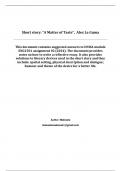Summary
Summary ENG1501: Short story "A Matter of Taste" by Alex La Guma. Suggested responses for (2024) assignment 02
- Course
- Institution
This document advise on how to write a reflective essay. It also provide suggestions on how to respond to the question of spatial setting, drawing from the short story "A Matter of Taste". Furthermore, it analyses Chinaboy's physical description and dialogue. It also discuss the humour used in the ...
[Show more]



